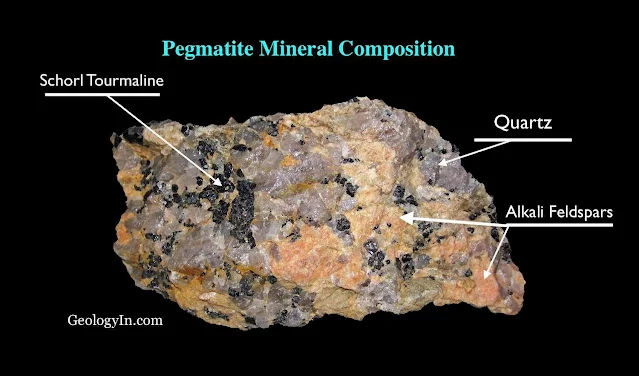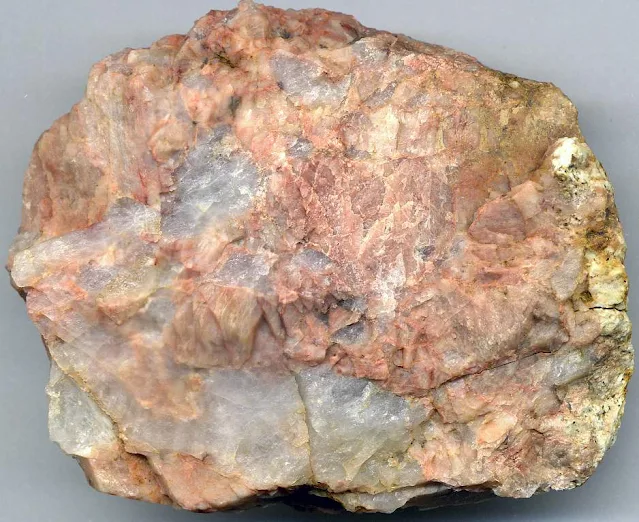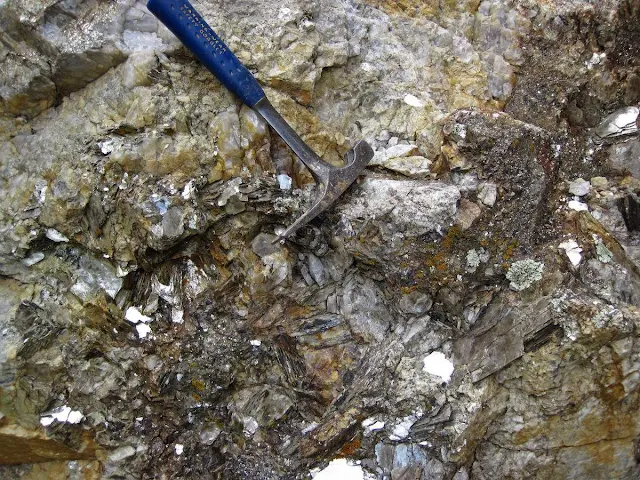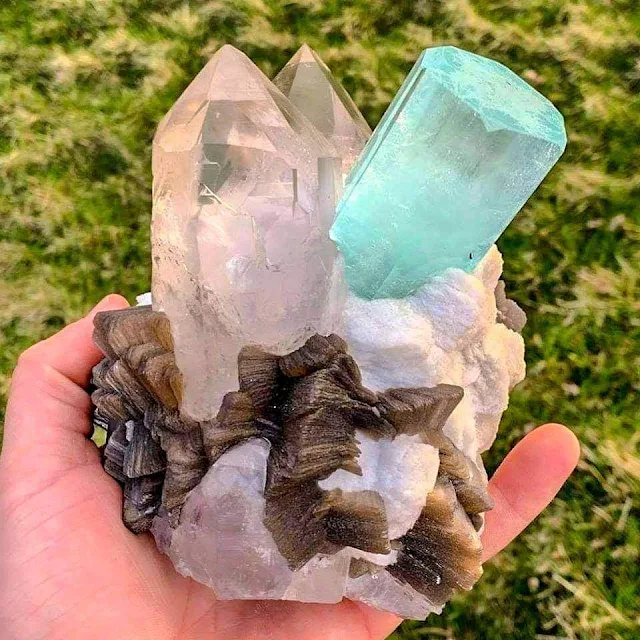Pegmatite: Formation, Composition, Properties, Uses
Pegmatite is a coarse-grained igneous rock, renowned for its exceptionally large crystals, Composed mainly of quartz, feldspar, and mica, it shares a similar composition to granite but differs significantly in its texture.
Pegmatite is an igneous rock distinguished by its exceptionally large crystals, typically exceeding 1 centimeter (0.4 inches) in diameter, and sometimes reaching even larger than 1 meter (3 feet). This characteristic coarse-grained texture sets them apart from the majority of igneous rocks, which are typically fine-grained.
Pegmatites name derived from the greek word "Pegma," meaning "Something fastened together," likely referencing the interlocking crystals within the rock.
Pegmatites Key Features
- Texture: Coarse-grained (phaneritic), crystals >1 cm, well-formed.
- Origin: Late-stage magma crystallization, enriched in volatiles and incompatible elements.
- Composition: Felsic (high silica, alumina), diverse minerals (quartz, feldspar, mica, lithium, REEs, etc.).
- Color: Variable based on minerals (grayish white, pink, black, gem colors).
- Economic Importance: Sources of lithium, tantalum, niobium, gemstones.
 |
| Pegmatite: White Plagioclase, Brown Biotite, Blue mineral Kyanite |
Pegmatite Formation
Pegmatites arise from the final stage of crystallization in magma chambers. As magma cools and solidifies, minerals start forming.
1. Magma Fractionation and Enrichment:
Crystallization of parent magma: As magma ascends within the Earth's crust, pressure drops, initiating crystallization. Minerals like quartz, feldspar, and mica solidify, depleting specific elements from the remaining melt.
Hydrothermal fluid generation: Volatile elements (H₂O, CO₂, F) concentrated in the melt become mobile, forming superheated fluids. These fluids dissolve and transport incompatible elements (Li, REEs, Ta, Nb) rejected during early crystallization.
2. Pegmatite Nucleation and Growth:
Fluid migration and infiltration: Hydrothermal fluids migrate through fractures or permeable zones within the surrounding rock, enriching specific locations with dissolved elements.
Pressure and temperature decrease: Cooling and decompressing fluids release dissolved minerals, forming pegmatite bodies within the host rock. The slow cooling rate facilitates the growth of large, euhedral crystals.
3. Mineral Assemblage and Diversity:
Geochemical signatures: The unique geochemical signature of the parent magma and the specific types of mobile elements in the fluids determine the mineral assemblage within the pegmatite.
Exotic mineral formation: Pegmatites can host a wider variety of minerals, including Li-rich spodumene, REE-rich tantalite, and rare gemstones like emeralds and tourmalines, due to the concentration of incompatible elements.
Factors Influencing Formation:
Parent magma composition: Determines the available incompatible elements for pegmatite mineralization.
Slow Cooling: Some experts suggest that slow cooling allows for the formation of large crystals in pegmatites. However, others propose that rapid cooling can also lead to pegmatite textures under certain conditions.
Hydrothermal fluids: Hot, water-rich fluids circulating through the magma can dissolve and transport minerals, further concentrating them and facilitating their growth into large crystals.
Crystallization pockets: Pegmatites often occur in pockets or veins within other rock formations, creating isolated environments conducive to the formation of giant crystals.
Pegmatite Mineral Composition
While most pegmatites share a similar composition to granite, they can exhibit a wider range of mineral assemblages. The most common minerals include:
 |
| Pegmatite Mineral Composition |
Quartz: Often forming the largest crystals, quartz gives pegmatite its characteristic white or pink color.
Feldspar: Potassium feldspar (microcline) and plagioclase feldspar are both common, adding to the rock's overall strength and stability.
Mica: Muscovite and biotite are the most common micas, contributing to the rock's platy texture and shimmering appearance.
Accessory Minerals:
Lithium-rich pegmatites: These specialized pegmatites are characterized by the presence of spodumene (LiAlSi₂O₆), a crucial source of lithium for modern technologies.
Rare-element pegmatites: These pegmatites contain a diverse assemblage of rare earth elements (REE), niobium (Nb), tantalum (Ta), and other valuable elements, often hosted in specific minerals like tantalite-(Mn,Fe)Ta₂O₆ and columbite-(Fe,Mn)Nb₂O₆.
Gemstone deposits: Some pegmatites host valuable gemstones like emeralds (Be₃Al₂(SiO₃)₆), aquamarines (Be₃Al₂Si₆O₁₈), and tourmalines (Na(Li,Mg,Fe,Mn,Ca)₃Al₆(BO₃)₃(Si₆O₁₈)(OH)₄).
Pegmatite Properties
Color: Pegmatites exhibit a diverse color palette due to their varied mineral composition. They can be:
- Light-colored: Dominated by quartz and feldspar, leading to white, gray, or pink hues.
- Greenish: Presence of mica, particularly muscovite, adds a greenish tinge.
- Reddish: Spodumene in lithium-rich pegmatites contributes a pink or red tone.
- Multicolored: Gemstone-bearing pegmatites showcase a dazzling array of colors (emeralds, aquamarines, tourmalines).
Texture: Pegmatites are characterized by a phaneritic texture, meaning their crystals are large enough to be seen with the naked eye. The crystals often interlock, creating a massive, cohesive rock.
Hardness: The hardness of pegmatites varies depending on their mineral composition. Quartz and feldspar, major constituents, exhibit a hardness of 6-7 on the Mohs scale, while softer minerals like mica (2-3) and spodumene (4-5) can also be present.
Mineral composition: Pegmatites can contain a diverse range of minerals, although specific combinations define different types:
- Granitic pegmatites: Dominated by quartz, feldspar, and mica, similar to granite.
- Lithium-rich pegmatites: Contain abundant spodumene, a vital source of lithium.
- Rare-element pegmatites: Host valuable minerals like tantalum, niobium, and rare earth elements.
- Gemstone deposits: May contain emeralds, aquamarines, tourmalines, and other precious stones.
Composition: The exact chemical composition of pegmatites varies according to their mineral assemblage. However, they are generally rich in silica (SiO₂) and alumina (Al₂O₃), with moderate levels of potassium (K₂O), sodium (Na₂O), and magnesium (MgO).
Density: Pegmatites have a relatively high density due to their large crystals and lack of pore space. They typically range from 2.6 to 2.8 g/cm³, although denser minerals like gemstones can increase the density further.
Weathering resistance: Pegmatites exhibit moderate to good weathering resistance. Quartz and feldspar, major components, are relatively resistant to chemical and physical weathering. However, softer minerals like mica and spodumene may weather faster, affecting the rock's long-term durability.
Magnetism: Variable, depending on the specific minerals present. Pegmatites can be:
- Strongly magnetic: Due to the presence of minerals like magnetite.
- Weakly magnetic: Due to minerals like ilmenite and pyrrhotite.
- Diamagnetic: Most minerals like quartz and feldspar exhibit weak repulsion to magnetic fields, negating any weak magnetism from other minerals.
Types of pegmatite
Granitic Pegmatite
 |
| Pegmatitic granite (alaskite) from Mt. Evans Batholith, Mesoproterozoic, Mt. Evans, central Colorado, USA. Photo: James St. John |
Granitic Pegmatite is The most common type, composed primarily of quartz, feldspar (plagioclase and potassium feldspar), and mica (muscovite and biotite). Often light-colored due to the dominance of quartz and feldspar similar in composition to granite. May host common gemstones like topaz, amethyst, and citrine.
Mica-Rich Pegmatite
 |
| Mica-Rich Pegmatit, White Cap Mine, east of Keystone, Black Hills, South Dakota Photo: James St. John |
Mica-Rich Pegmatite is Distinguished by an abundance of mica, particularly muscovite or biotite, sometimes exceeding 50% of their composition. Can be used for electrical insulation, decorative purposes, and as an ingredient in certain cosmetics.
Aplite Pegmatites
Finer-grained compared to other pegmatites, but still exceeding the average grain size of typical fine-grained igneous rocks. Composition is similar to granitic pegmatites, but with a higher proportion of feldspar and a lack of large mica crystals. Often occur as dikes or veins associated with pegmatite intrusions.
Syenitic Pegmatite
 |
| Syenitic Pegmatite, Huge potassium feldspar crystal at Ruggles Pegmatite Mine, southern New Hampshire, USA. Photo: James St. John |
Less common, characterized by a higher content of alkali feldspar (microcline and orthoclase) compared to granitic varieties. Tend to have a pinkish or reddish tinge due to the alkali feldspar abundance. Valued sources of rare earth elements (light REEs like lanthanum and cerium), zirconium, and sometimes gemstones like sapphires and zircons.
Mafic pegmatite
Gabbroic pegmatites or Mafic pegmatite: Rare type, with significant amounts of mafic minerals like pyroxene and amphibole. They can be sources of minerals like titanium and zirconium.
 |
| Aquamarine, Quartz, and Muscovite combo on albite all on Pegmatite, from Shigar valley, Pakistan! |
Where Are Pegmatite Rocks Found
Pegmatites are most commonly found in association with large intrusive igneous bodies, particularly granitic batholiths. They typically form within or alongside these massive rock formations, like jewels nestled within a crown. Some pegmatites occur as veins or dikes that intrude into surrounding rocks, offering glimpses into their hidden geological history.
Major Occurrence Locations:
North America: The Canadian Shield, Appalachian Mountains, and Rocky Mountains boast numerous pegmatite occurrences, some hosting valuable lithium and rare earth element deposits.
- Black Hills of South Dakota, USA: Home to spodumene crystals over 12 meters long.
- New England Pegmatite Province: Stretching from Maine to Connecticut, known for tourmaline, beryl, and other gemstones.
- Lithium pegmatites of the Carolina Tin-Spodumene Belt: Significant for lithium resources.
- Pegmatites of the Grenville Province in Canada: Host a variety of rare minerals, including pollucite (a source of cesium).
South America: Pegmatites are found in the Brazilian Shield, hosting tantalum, niobium, and gemstone deposits.
- Brazil's Eastern Pegmatite Province: This extensive pegmatite belt produces tantalum, niobium, lithium, and gemstones, including notable tourmaline and aquamarine deposits.
- The Colombian emerald belt: World-renowned emerald deposits are associated with pegmatites in this region.
Africa: Pegmatites are abundant in the African Shield, particularly in Namibia and Madagascar, known for their lithium and rare earth element potential.
- Greenstone Belts of Southern Africa: Hosts numerous pegmatites, including the Palabora complex in South Africa, known for copper, phosphate, and vermiculite.
- Namaqualand Complex in South Africa: Notable for its lithium-bearing pegmatites.
- Bikita pegmatite field in Zimbabwe: A significant source of lithium, beryllium, and tantalum.
Europe: The Scandinavian Peninsula and Central Europe host pegmatites, some containing gemstones like emeralds and aquamarines.
- The Oslo Graben in Norway: This rift valley hosts numerous pegmatite occurrences, including those rich in rare earth elements, beryllium, and gemstones like tourmaline.
- The Ural Mountains in Russia: These mountains contain various pegmatites, including sources of rare earth elements, tantalum, and gemstones.
Asia: Pegmatites are found in the Indian Shield, Central Asia, and Southeast Asia, with some hosting valuable minerals like tin and tungsten.
- The Himalayas: Pegmatite occurrences in the Himalayas have yielded notable gemstones, including aquamarines and tourmalines.
- Spodumene deposits in China and Australia: These pegmatites are crucial sources of lithium for battery production.
 |
| Banded Pegmatite (Portugal) |
Australia: Pegmatites are present in the Australian Shield, particularly in Western Australia, known for their lithium and tantalum deposits.
Pegmatites Uses
Pegmatites, with their impressive crystal size and diverse mineral composition, offer a treasure trove of uses across various industries and applications. Here's a breakdown of their key uses:
Industrial Uses
Lithium extraction: Pegmatites are vital sources of lithium, a critical element for batteries in electric vehicles, smartphones, and other electronics. Minerals like spodumene and petalite are key contributors to the global lithium supply.
 |
| Spodumene Pegmatite Primary Source of Lithium |
Feldspar production: Feldspar, a dominant mineral in pegmatites, is used in the production of glass, ceramics, and construction materials. Its various forms offer different properties for various applications.
Rare earth elements (REEs): Pegmatites can host a variety of REEs, crucial for magnets in wind turbines, lasers, and catalysts for pollution control. Specific types like LCT and NYF pegmatites are particularly valuable for their REE content.
Other minerals: Pegmatites can also be sources of minerals like mica (used in electronics and insulation), tantalum (for capacitors and cutting tools), niobium (for alloys and superconductors), and beryllium (for aerospace and nuclear applications).
Gemstone Deposits
Emeralds, aquamarines, and tourmalines: Some pegmatites are renowned for their dazzling gemstone deposits, adding a precious dimension to their economic value. Gemstone pegmatites can be lucrative sources of these coveted stones for jewelry and ornamental purposes.
Other gemstones: Pegmatites can also host other valuable gemstones like sapphires, zircons, and chrysoberyls, depending on their specific composition and geological history.
Architectural Applications
Granitic pegmatites: With their attractive appearance and durability, some pegmatites can be used as building materials. They can be cut, polished, and used for countertops, flooring, and decorative elements.
Research and Scientific Value
Understanding geological history: Pegmatites provide valuable insights into the formation and evolution of igneous rock formations. Studying their mineral assemblages and textures can reveal clues about the past geological conditions and processes.
Identifying new mineral deposits: Pegmatites are often associated with other mineral deposits, making them potential indicators for further exploration and resource discovery.
 |
| Huge amazonite crystals in pegmatite from The Morefield Mine is in Amelia County, Virginia |
Pegmatite Significance
Pegmatites are scientifically significant for several reasons:
- Giant crystals: They provide valuable insights into crystal growth processes and the conditions necessary for forming such large crystals.
- Rare minerals: They are a treasure trove of rare and valuable minerals with diverse applications in electronics, jewelry, and other industries.
- Geochemical indicators: Their mineral composition can reveal information about the chemical composition and evolution of the parent magma.
Pegmatites vs. Granites
Both pegmatites and granites are classified as Phanerozoic igneous rocks, arising from the solidification of molten magma. However, they exhibit distinct characteristics in terms of texture, mineralogy, and formation processes:
Texture:
- Pegmatites: Characterized by a coarse-grained (phaneritic) texture, featuring crystals typically exceeding 1 cm in size. This results from slow cooling and enrichment of specific elements in the late stages of magma crystallization.
- Granites: Typically exhibit a medium-grained (phaneritic) texture, with crystals ranging from a few millimeters to a few centimeters. They may cool faster or under different pressure conditions compared to pegmatites
Mineralogy:
- Pegmatites host a diverse mineral cast, including lithium-rich stars and rare-earth element gems. Granites stick to a simpler family, focusing on quartz, feldspar, and mica.
 |
| “Pegmatite page” – page 36 of R. L. Bonewitz, “Rocks and Minerals |
Summary
Pegmatites are more than just rocks; they are geological treasures with a story to tell and a valuable contribution to make. Their unique characteristics, diverse composition, and economic significance make them captivating subjects for both scientific study and practical applications. Understanding and appreciating these remarkable rocks enriches our understanding of the Earth's history and paves the way for sustainable utilization of their valuable resources.
Read also:
Scoria - Formation, Uses, Types of Scoria
Dunite - Formation, Composition and Properties
Obsidian: Types, Varieties of Obsidian With Photos
References
- Heinrich, E. W. (1960). Pegmatites and their giant crystals. American Museum of Natural History, New York.
- Bateman, P. C. (1995). The role of fluids in pegmatite formation and mineralization. Economic Geology and the Bulletin of the Society of Economic Geologists, 90(6-8), 1015-1039.
- Staude, J. C. A., & Marques, F. (2005). Lithium-bearing pegmatites: Geology, mineralogy, and economic importance. Springer Science & Business Media.
- Bonewitz, R. L. (2012). Rocks and minerals (2nd ed.). DK Publishing.

%20(1).webp)






